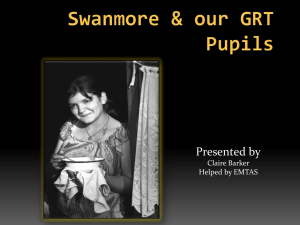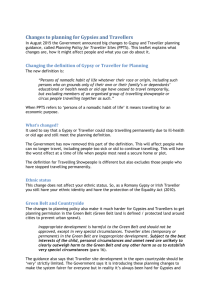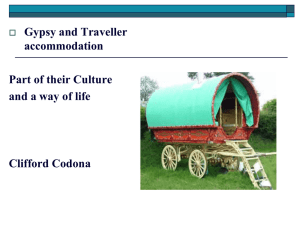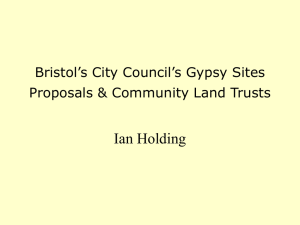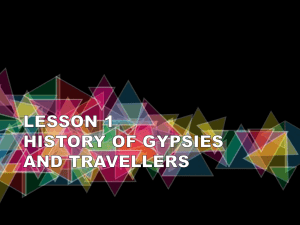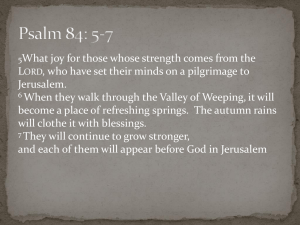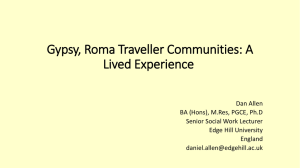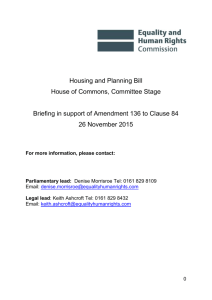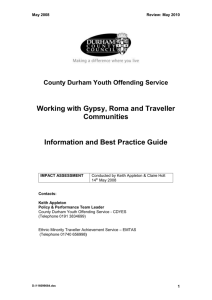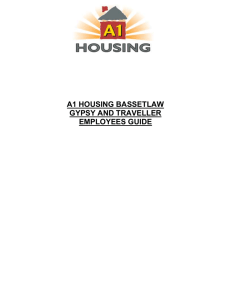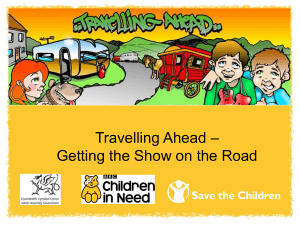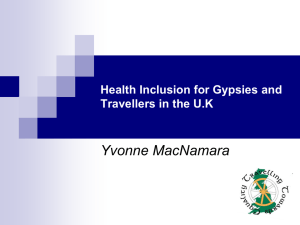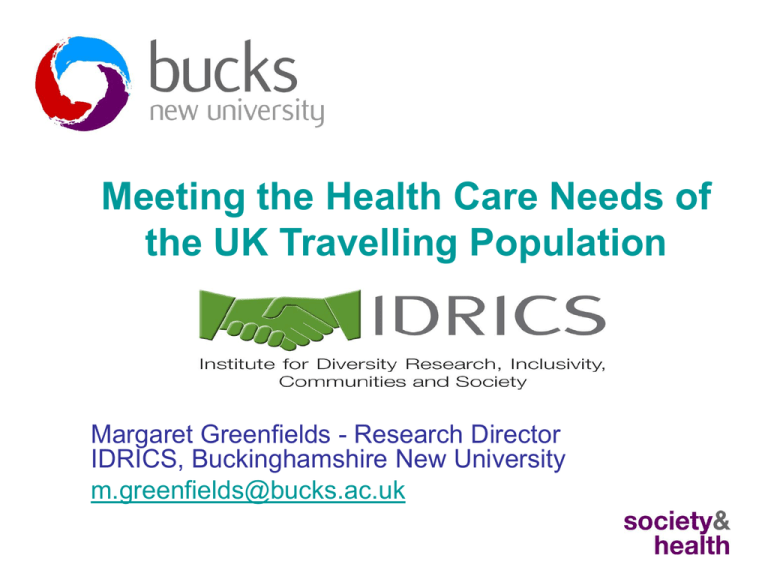
Meeting the Health Care Needs of
the UK Travelling Population
Margaret Greenfields - Research Director
IDRICS, Buckinghamshire New University
m.greenfields@bucks.ac.uk
Background information
• Romany (English/Welsh) Gypsies recognised as ethnic minorities in
1989; Irish Travellers (2000) Scottish Gypsy-Travellers (2008).
Roma also subsumed into the categories of protected communities
under the ruling in the 1989 case.
• At least 300,000 Gypsies and Travellers resident in Britain (CRE,
2004). Some estimates (controversially) suggest in excess of one
million Roma have become are resident in the UK in the 1990s2000s although best estimates tend to assume around 500,000
people from diverse EU countries (see Craig, 2011).
• Approximately 2/3 believed in reside in housing (Cemlyn et. al.,
2009)
• As of 2011 approximately 20% of Gypsy/Traveller caravans are
stationed ‘unlawfully’ rendering the occupants technically homeless.
• Evidence from GTAAs suggests that Romany Gypsy women have
an average of 3.5 and Irish Traveller women 5.9 children. Limited
information to date on Roma family size in the UK.
Disadvantage and Social Exclusion
• Stonewall ‘Profiles of Prejudice’ Survey 2001 – 35% of
survey population prejudiced against Gypsies &
Travellers
• Scottish Social Attitudes (Bromley et. al. 2007) 37%
respondents would be very unhappy if a relative married
a Traveller-Gypsy
• CRE – discrimination against Gypsies and Travellers the
last ‘respectable’ form of racism (2005)
• In excess of 90% of Gypsies and Travellers interviewed
for GTAAs (all forms of accommodation) report
experiences of enacted racism
Accommodation Issues
Shortage of Sites/ some extremely poor quality/limited spend on
upgrade and repair
20% caravan dwelling G&T households are ‘homeless’
Discrimination in the Planning Process (90% first applications fail –
2003)
Increase in retrospective permissions 2003-2007
GTAAs were offering glimmers of hope however changes to planning
regime and localism likely to have a severe and negative impact on
outcomes of planning applications.
TAT review (2011) and Ryder et. al. (2012) critique of Government
policy, indicates most professionals are concerned that new policy
initiatives and cuts will worsen the situation cf: Dale Farm Autumn
2011
Experiences of Housed Gypsies and Travellers
Racism and Discrimination/Anxiety and Depression
Roma migrants largely overcrowded and in poor accommodation –
however anecdotally significant improvement on many former
housing conditions – reports of ‘passing’ as Asian/Middle
Eastern minimising discrimination….
High rates of tension and racism around sites/unauthorised encampments – physical abuse
and threats common
Unauthorised Encampment
Educational Issues
• Widespread adult illiteracy (estimated 35-40% of the
whole population) TLRU 2001
lack of access to schools
high mobility
experiences of bullying
early age of starting work
low cultural expectations of education 50%+ of sample in
BNU/ARU research (2006) could not undertake basic tasks
‘easily’ or ‘feel comfortable’ when reading, writing or completing
a simple form.
• Roma Migrant adults have frequently experienced poor
quality, segregated and abruptly terminated educational
experienced. Young people in contrast as achieving
relatively well in the UK system often outperforming
Gypsy and Traveller pupils (see Ryder et. Al., 2011)
• Gypsy/Traveller pupils as “the group most at risk in the
education system today” – Ofsted 1999/2003
• Decline in attendance at secondary level (1/3 of
children registered on school roll as
Gypsy/Roma/Traveller when start school still in
school at Key Stage 4) DfES 2005/ TAT Review
2011
• >85% of children experiencing racist bullying
(GTAA evidence)
• 25% of self-identified GRT pupils met ‘national
expectations’ in terms of 5 GCSEs and of these
12% v 58.2% of all pupils attained 5+ A*-C
grade (2011 DFS data/TAT panel review).
• Bullying frequently cited as a reason for early
school leaving as well as cultural concerns over
curriculum (sex education, exposure to
substance abuse, mixed- gender schools, etc)
Travellers’ Health I
• Data in UK largely predicated on Gypsy and Traveller health
studies. Roma to date largely unresearched.
• High rate of heart disease; diabetes: premature morbidity and
mortality (Parry et, al., 2004; Matthews, 2008; Cemlyn et. al., 2009)
• Decreased life expectancy – by 12 years women 10 years for men
(Crawley, 2003) Leeds Baseline Census, (2005) indicates only 2.3%
Gypsies and Travellers aged 60+
• Greatly increased levels of perinatal mortality and stillbirth (Hajioff
and McKee, 2000; Sheffield Health Study, 2004; Matthews, 2008)
• High childhood accident rate (Beach, 1999) and death from
preventable diseases (Measles outbreak 2007)
• 18% of G&T women have experienced the death of a child (Parry
et. al., 2004)
• Dramatic decline in health status over the age of 50 – GTAA
evidence and see further Cemlyn et. al. 2009.
Travellers’ Health II
• Environmental health issues – contaminated
land, roadside encampments, etc (Clarke, 1998;
Home and Greenfields, 2006; etc.)
• “one young girl died from cancer, she didn’t even know
she had cancer in the womb and had been on the site
for 9 months and that’s one of the sites that are on a
sewer bed or rubbish tips and children are picking up
meningitis and kidney infections” (Richardson et al
2007).
• Lowered rates of childhood immunisation for
children where specialist Traveller Health
Visitors are not available (Davis & Hoult, 2000;
Parry et al, 2004; Matthews, 2008)
Disused Pitch and Utility Block
Local Authority Site
Culture Specific Impacts of Grief and
Bereavement
•
•
•
•
•
Close-knit nature of Gypsy and Traveller culture, high birth rate and pattern
of extended family residence means that the death of an individual is
keenly felt as a loss by a large number of kin including significant number of
children.
“X lost his little girl too. His wife has died too. She was only 31 when she
died... two little children he’s got”
“I suppose with us when you lose your mother, your head of the family,
you’ve lost your mentor so you’re having to fill a pair of shoes as well as
grieve a pair of shoes. When you lose one of your children its worse. You
can’t explain the pain or the hurt when you’ve lost a kid”.
“I’m 36, I’ve lost two brothers [road accidents] a sister [cancer], my Daddy
[heart attack] and one of my children [congenital illness] are gone before”
Bereavement and grief leading to high rates of long-term untreated
depression and anxiety can impact on family functioning (Van Cleemput,
2007; Goward, et. al., 2006) exacerbated by lack of access to services,
limited cultural knowledge of surrounding sedentary communities and
casual racism.
•
•
Impacts of frequent moving/insecure accommodation impacting on access
to treatment, support and long-term care
“Its like X down there that lost his baby in a cot death they were on the land
for about 2 weeks and were invaded by police for 2 weeks and social
services and that pathetic lot. She’s never recovered and then of course no
quicker than the little child was buried, the baby’s belongings and everything
were burned in the caravan, the next day they were evicted and of course
that woman wasn’t there to get any care. She needed care, she needed
somebody, a woman doctor, to say its alright my baby, everything is alright”.
(Richardson, et. al., 2007)
• Mother discharged from hospital 2 days after late miscarriage –
evicted from roadside site 48 hours later, given prescription for antidepressants – still taking them 10 years after event – no review of
medication known to have occurred. Eldest daughter 17 responsible
for household functioning and care of siblings [MG case files]
• “bereaved parents stated that GPs overwhelming failed to offer counselling
after a death preferring to ‘fob them off with a handful of pills’ (Richardson,
et. al., 2007)
Depression and Anxiety
• Parry et. al. (2004) found that residence in housing is for many
Gypsies and Travellers associated with high rates of anxiety and
depression. Frequency of ‘Travelling’ appears to act as a protective
factor.
• Only one robust identified study on Roma health (East London) Tobi
et. al, 2010 – found high levels of depression and anxiety
associated with previous experiences of discrimination and housing
stress.
• Residence in housing is for many (although not all) Gypsies and
Travellers associated with enforced settlement as a result of lack of
sites (Cemlyn, et al., 2009)
• For many individuals, not only lack of appropriate accommodation,
but loss of contact with a close-knit family and experiences of
racism and discrimination lead to failure of housing placement or
mental ill-health (“nerves”)
• Older or disabled Gypsies and Travellers may report transfer into
housing as a result of lack of suitable adaptations to caravans.
• Housing may be associated with greater comfort but can lead to
people feeling “like a bird in a cage” (Greenfields and Smith, 2007)
Learning Disabilities
•
•
•
•
No specific studies are known to exist in relation to the extent of learning
disabilities and culturally specific needs of Gypsies, Travellers and Roma in
the UK.
In part, given the acceptance of all forms of disability amongst GRT
families, and a reluctance to seek specialist help (and qualitative/anecdotal
data suggesting help may not be forthcoming when requested from local
authority and health services) this is likely to relate to a lack of family
identification of such needs other than in cases of profound disability.
Greenfields (2008) study of young Gypsies and Travellers attitudes to
health and social care employment found relatively high levels of casual
discussion amongst focus group participants on the learning disabilities of
relatives and friends’ family members suggesting both a comfortableness
with individuals with such disabilities and the commoness of the situation.
Anecdotally, and based on research experience, termination of pregancy
arising from diagnosed Downs Syndrome or similar condition would be
‘unthinkable’. “you love whoever God sends you – how can people put
someone away [terminate pregnancy, send for adoption, or place in a
residential facility] because they are special”
•
•
•
Secondary analysis of GTAA evidence – on-going suggests that 39% of
Gypsies and Travellers are caring for/supporting a family member with a
long term disability which impacts on their daily life. This is notably higher
than amongst surrounding populations which is estimated at 10% of the
population, (Papworth Trust, 2011).
Whilst the existing data on GRT people and disabilities is not easily broken
down into physical and learning disabilities, emergent data on the
percentage of individuals living with a family member with epilepsy (often
associated with learning disabilities) suggests a significantly higher
prevalence rate than is found in ‘mainstream’ society (see further
Richardson et. al., 2007).
Limited analysis of existing qualitative data suggests that GRT respondents
experience of barriers to accessing services exacerbate the existent
stresses and difficulties of caring for a family member with LD, although
strong family support and ‘normalisation’ of home based care increases
resilience. Where residence in caravans is desired by family members
there are often significant delays in obtaining adaptations and GTAA
evidence suggests that many households undertake adaptations
themselves to their internal and external environment on sites (e.g. building
ramps, etc) for people with LD and physical disabilities.
Women’s Health
•
•
•
•
•
•
•
Gypsy and Traveller societies are highly ‘gendered’.
Significant taboos exist on speaking of sexual health, gynaecological
matters and pregnancy related issues before members of the opposite sex.
The relatively high birth rate and fairly high percentage of disabled family
members reported in GTAA evidence can place significant caring
responsibilities upon women.
Coupled with frequent moving, or residence in insecure accommodation,
this can impact on women’s ability to access preventative health services –
with women often minimising their own needs.
Low rates of cervical and breast screening have been found amongst these
communities – with women expressing particular reluctance to attend
clinics where no guarantee exists that female staff will be on duty.
Research evidence that in her 50s a Traveller woman may be the female
head of her family with her older female relatives all having pre-deceased
her.
Accordingly older women can be a a conduit of information and support for
younger family members
Lack of ‘cultural awareness/competence’ amongst
service providers
• Health/Social care/Voluntary sector staff: failure to understand the
importance of kin-group responsibilities (e.g family demands made
by even quite distant relatives may be regarded as higher priority
than professional expectations) – failure to attend appointments etc.
• Literacy difficulties (and evictions, etc) as barrier to keeping
appointments (Greenfields, 2008; Cemlyn et. al. 2009; Van
Cleemput, 2010). See Tobi et. Al. (2010) for similar findings in
relation to Roma migrants.
• Support of family: gathering to support a person having medical
treatment, (Lehti and Mattson, 2001) or following a bereavement –
can lead to conflict with police/hospital and local authorities over
numbers of visitors or caravans/vehicles parked at a specific
location.
Men’s Health
• Little research has been undertaken into men’s health amongst the
Gypsy and Traveller communities.
• Evidence exists of relatively high rates of smoking and drinking
(Parry et al, 2004) and considerable anecdotal evidence, supported
by small scale localised studies suggest excessive rates of cardiovascular disease implicated in premature mortality.
• Stress, a more sedentary lifestyle than in the past, and changing
eating habits have been implicated in high rates of diabetes and
associated ‘diseases of affluence’
• A culture of male stoicism and presumption of poor health from a
relatively early age is associated with untreated medical conditions
and preventable mortality or morbidity (see Van Cleemput et al,
2007; Matthews, 2008)
Barriers to Engaging with Services
• Problematic of accessing GP and hospital
appointments (Power, 2004; Parry et. al., 2004;
Matthews, 2008)
• Suspicion in relation to engaging with health
staff,language barriers and lack of awareness of rights
for Roma people (Poole and Anderson, 2008; Tobi et
al. 2010)
• Communication (and travel) difficulties when accessing
medical/social care and voluntary sector agencies
(Power, 2004; Parry et. al., 2004; Cemlyn et. al., 2009)
• Lack of facilities for terminal care on Gypsy/Traveller
sites means that death may occur in hospital rather
than (as may be preferred) amongst family at home
(Jesper et. al, 2008) .
•
Inequalities in registration with GPs – discrimination, mismatch in
expectations, ‘expensive’ patients; lack of preventative health care, etc.
(Hawes, 1997; Van Cleemput, 2000; Matthews, 2008; Cemlyn et. al., 2009)
•
Over-reliance on A&E departments (associated with GP registration
problems/long delays and avoidance of ‘gate-keeping’ receptionists), and
consistent anecdotal evidence of avoidable mortality resulting from lack of
early health intervention (Cemlyn et.al, 2009)
•
Fast tracking of Gypsies and Travellers to preventative services as part of
NHS Primary Care Framework protocol (2009) – in recognition of high level
of unmet need and health inequalities.
•
2012 inter-ministerial review – indications that Inclusion Health will be
retained.
•
Projects with Gypsies and Travellers currently under development
(FFT/LeedsGATE, NIHR Immunisation research etc.) See Van Cleemput
(2012) review article on impact of Inclusion Health programmes.
Womens’ Health
Programme: Aims & Content
Rationale for Project
• Research suggests that community members would
welcome advice & care provided by trained/qualified
community members (Greenfields, 2008)
• Culturally appropriate educational materials and use of
trusted community members as health advocates (in line
with work carried out with other BME communities) are
anticipated to reduce negative health impacts of
membership of GRT communities.
• Proposal – to devise a training programme targeted at
Gypsy and Traveller women to equip them to signpost
services and provide health advocacy support to their
peers.
Programme Aims & Content
• The project was devised in partnership between One Voice
4 Travellers Ltd, Bucks New University, Buckinghamshire
Primary Care Trust and Buckinghamshire Community
Foundation (funders)
• Key Aims: to undertake a culturally sensitive community
health needs assessment of site residents [on-going]
• utilise community advocate skills to provide training and
delivery of advice and information on specific health needs
(such as accessing screening for cardio-vascular health or
promoting healthy eating) to site residents
• Focus particularly on the health needs of older women and
young mothers as a gateway to family health improvement
• Topics include: delivery on sensitive topics such as
emotional wellbeing (based on Mental Health First Aid);
recognising impacts of DV on children/families and
communities; substance misuse as well as ‘women’s health’
Headline Findings – Health Audit
• 27 respondents - 65% female
• Age range – 18-65+ (only 2.5% were pensioners)
• 22 (81%) reported being registered with a GP – 17
(63%) of whom in Buckinghamshire
• 16 (59%) reported being registered with a dentist – 11
(41%) of whom with an NHS dentist
• 4 (15%) had seen or were registered with an optician
• Generally respondents visit a GP/dentist only when they
have a specific problem
• Tendency for children to have more regular access than
parents, and for men to have least access. There is
frequent praise for children’s health care provision by
GPs
• 10 respondents (37%) reported problems registering – but 14 (52%)
had experienced ease of registration/or made a point of going to
surgeries familiar with enrolling Travellers
• 14 (52%) reported dissatisfaction with dealing with Reception staff
–
• 18.5% reported respiratory problems in their household;
• 22% of families had a resident with diabetes;
• 15% cardiac problems+ 15% epilepsy
• 7% stroke(s).
• 34% had someone with mobility problems;
• 26% reported someone with blindness/eyesight difficulties;
• 11% deafness or hearing problems and 15% epilepsy.
• In addition;
• 18.5% of households had someone experiencing mental
illness/depression.
• Overall 60% of respondents felt they had access to appropriate
and adequate healthcare.
Mean number of people living in each household – 4.17 (ranging
from household size of 1 to 15)
70% of households surveyed had children
30% housed one generation, 52% housed 2, 9% 3 (including a
mother with two children caring for a grandmother) and 4%
housed 4 generations
4 households included a woman who identified as being a carer
for a household member and a further 3 households included a
carer for someone living in a separate ‘unit’ or trailer – not
always on the same site.
Aspiration – To experience continuity of care: A young female
noted that: “It can be hard to talk to them and tell them things
when you don’t know them”. An elderly man stated: “We would
like to [ build a relationship with one service provider]. Would
not have to keep explaining [ourselves/our lives]”
Project Outcomes
• The six people currently working as health advocates in their
community report confidence in sharing health information and
offering advice to their peers and further afield (e.g. Activities at
Gypsy horsefairs).
• The training has helped to prepare them to be able to maintain
confidentiality, has developed interview skills and empowered
theme to help community members.
• Feedback received from participants on the course tell us that they
are actively passing on information to their husbands, parents and
neighbours, e.g. first aid skills
• The interactive delivery of drug awareness and education using a
drug box containing commonly used imitation drugs, has proved to
be a useful tool for engaging and facilitating group discussions
between students and presenters.
• Local health audit devised with the intent of informing local health
care delivery (see headline data above).
• Key success has been that cultural and language
barriers have been overcome so that advocates and
communities are exchanging terms such as ‘nerves’ for
mental health to reflect the true meaning of both positive
and negative aspects to wellbeing. Professionals who
participated in the programme report higher levels of
cultural awareness and better links into neighbourhood
groups.
• Smoking Cessation Intervention (follow-up one day
training) completed May 2011 – access to funding has
led to delays in continuing the programme but culturally
appropriate smoking cessations materials are currently
under development.
She said: “Due to my lifestyle this course and the practical tips I’ve received could potentially prove life-saving. For example, we visited t
Participant Feedback
• “Due to my lifestyle this course and the practical tips I’ve
received could potentially prove life-saving. For
example, we visited the Uxbridge Campus and were
given a class in resuscitation and how to place people in
a recovery position”.
• “The other women and I can now work as health
advocates across all of the Traveller communities and
use what we have learnt to benefit others. I have a much
clearer, balanced picture now, and can actually help
people by giving them proper advice and the truth.”
Key Resources on Traveller Health
•
Cemlyn, S., Greenfields, M., Burnett, S, Whitwell, C & Matthews, Z. (2009),
Inequalities experienced by Gypsy and Traveller Communities: A Review,
London: Equality and Human Rights Commission.
•
Clark C & Greenfields M (eds.) (2006) Here to Stay: The Gypsies and
Travellers of Britain, Hatfield: University of Hertfordshire Press
•
Greenfields, M (2009) Reaching Gypsies and Travellers Primary Health
Care 19(8) pp26-27
•
Matthews, Z (2008) The health of Gypsies and Travellers in the UK London:
Race Equality Foundation
Parry G, Van Cleemput P, Peters J, Moore J, Walters S, Thomas K &
Cooper C (2004) The Health Status of Gypsies and Travellers in England
Sheffield: ScHARR
•
•
Ryder, A., Acton, T., Alexander, S., Cemlyn, S., Greenfields, M.,
Richardson, J., Smith, D. and Van Cleemput, P. (2011), A Big or Divided
Society? Final Recommendations and Report of the Panel
•
Review into the Coalition Government Policy on Gypsies and Travellers,
Travellers Aid Trust: Carmarthenshire.
•
Ryder et.al., (2012) A critique of UK Government policy on Gypsy, Traveller
and Roma Communities http://www.edf.org.uk/blog/wp-
Web Resources
• Derbyshire Gypsy Liaison Group
http://www.dglg.org/publications-health.php
• Friends, Families and Travellers http://www.gypsytraveller.org/health
• Irish Traveller Movement (Britain)
http://www.irishtraveller.org.uk/
• Leeds Gypsy and Traveller Exchange
http://www.leedsgate.co.uk/
• Pavee Point http://www.paveepoint.ie/
Questions?
Discussion Points?
The Way Forward in Wales?

